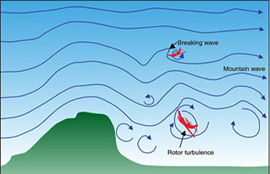|
Relating to The Earl E. Myers Story Mountain Wave Information Attachment |
|||||||||
|
Mountain Wave Turbulence In Australia, mountain waves and 'rotors' are commonly experienced over and to the lee of mountain ranges in the south-east of the continent. They often appear in the strong westerly wind flows on the east coast in late winter and early spring. |
|||||||||
 |
 |
||||||||
|
Graphic A |
Graphic B |
||||||||
| Rotors or eddies can also be found embedded in mountain waves. Formation of rotors can also occur as a result of down slope winds. Their formation usually occurs where wind speeds change in a wave or where friction slows the wind near to the ground. Often these rotors will be experienced as gusts or windshear. Clouds may also form within a rotor.
Many dangers lie in the effects of mountain waves and rotors on aircraft performance and control. In addition to generating turbulence that has demonstrated sufficient ferocity to significantly damage aircraft or lead to loss of aircraft control, the more prevailing danger to aircraft in the lower levels in Australia seems to be the effect on the climb rate of an aircraft. General aviation aircraft rarely have performance capability sufficient to enable the pilot to overcome the effects of a severe downdraft generated by a mountain wave or the turbulence or windshear generated by a rotor. In 1996, three people were fatally injured when a Cessna 206 encountered lee (mountain) waves. The investigation report concluded, "It is probable that the maximum climb performance of the aircraft was not capable of overcoming the strong downdrafts in the area at the time". Crossing a barrier into wind also reduces the groundspeed of an aircraft and has the effect of keeping the aircraft in the area of downdraft for longer. An aircraft flying downwind is likely to place an aircraft in an updraft as it approaches rising ground. Rotors and turbulence may also affect low level flying operations near hills or trees. In 1999, a Kawasaki KH-4 hit the surface of a lake during spraying operations at 30 feet. The lack of sufficient height to overcome the effects of wind eddies and turbulence was implicated as a factor involved in the accident. Research into mountain waves and rotors or eddies continues but there is no doubt that pilots need to be aware of the phenomenon and take appropriate precautions. Although mountain wave activity is normally forecast many local factors may effect the formation of rotors and eddies. When planning a flight a pilot should take note of the winds and the terrain to assess the likelihood of waves and rotors. There may be telltale signs in flight, including the disturbances on water or wheat fields and the formation of clouds, provided there is sufficient humidity to provide for cloud formation. Some considerations include allowing for the possibility of significant variations in the aircrafts altitude if up and downdraughts are encountered. A margin of at least the height of the hill or mountain from the surface should be allowed. Ultimately, it may be preferable for pilots to consider diverting or not flying, rather than risk flying near or over mountainous terrain in strong wind conditions conducive to mountain waves and rotors. Further Reading * Bureau of Meteorology. (1988). Manual of meteorology part 2: Aviation meteorology. Canberra, ACT: Australian Government Publishing Service. End of Mountain Wave Information |
|||||||||